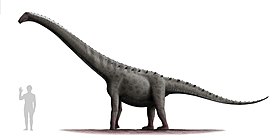Rinconsauria
Stratigrafický výskyt: Svrchní křída (asi před 89 až 70 miliony let) | |
|---|---|
(c) I, Steveoc 86, CC BY-SA 3.0 Rekonstrukce vzezření rodu Rinconsaurus | |
| Vědecká klasifikace | |
| Říše | živočichové (Animalia) |
| Kmen | strunatci (Chordata) |
| Třída | plazi (Sauropsida) |
| Nadřád | dinosauři (Dinosauria) |
| Řád | plazopánví (Saurischia) |
| Podřád | sauropodomorfové (Sauropodomorpha) |
| Infrařád | sauropodi (Sauropoda) |
| Nadčeleď | Rinconsauria Calvo et al., 2007 |
| Některá data mohou pocházet z datové položky. | |
Rinconsauria („Ještěři z Rincón de los Sauces“) byl klad sauropodních dinosaurů ze skupiny Lithostrotia (vývojově vyspělých titanosaurních sauropodů), kteří žili v období svrchní křídy (geologický stupeň coniac až maastricht), asi před 89 až 70 miliony let.
Klasifikace
V současnosti řadíme do tohoto kladu pouze pět rodů sauropodních dinosaurů, a to rody Rinconsaurus, Muyelensaurus, Punatitan, Bravasaurus a Chadititan.[1] Tyto rody dále spadají do kladu Colossosauria.[2] Klad byl formálně stanoven v roce 2007.[3]
Odkazy
Reference
- ↑ Agnolín, F. L.; et al. (2025). New fossiliferous locality from the Anacleto Formation (Late Cretaceous, Campanian) from northern Patagonia, with the description of a new titanosaur. Revista del Museo Argentino de Ciencias Naturales. 26 (2): 217–259.
- ↑ González Riga, Bernardo J.; Lamanna, Matthew C.; Otero, Alejandro; Ortiz David, Leonardo D.; Kellner, Alexander W. A.; Ibiricu, Lucio M. (2019). "An overview of the appendicular skeletal anatomy of South American titanosaurian sauropods, with definition of a newly recognized clade". Anais da Academia Brasileira de Ciências. 91 (suppl 2): e20180374. doi:10.1590/0001-3765201920180374.
- ↑ Calvo, J. O.; et al. (2007). A new titanosaur sauropod from the Late Cretaceous of Neuquén, Patagonia, Argentina. Arquivos do Museu Nacional, Rio de Janeiro. 65(4): 485-504.
Literatura
- Mannion, P. D.; Upchurch, P.; Jin, X.; Zheng, W. (2019). New information on the Cretaceous sauropod dinosaurs of Zhejiang Province, China: impact on Laurasian titanosauriform phylogeny and biogeography. Royal Society Open Science. 6 (8). doi:10.1098/rsos.191057.
Externí odkazy
- Profil taxonu na databázi Fossilworks Archivováno 19. 7. 2020 na Wayback Machine. (anglicky)
Média použitá na této stránce
Autor:
- Information-silk.png: Mark James
- derivative work: KSiOM(Talk)
A tiny blue 'i' information icon converted from the Silk icon set at famfamfam.com
(c) I, Steveoc 86, CC BY-SA 3.0
A restoration of Rinconsaurus compared to a human ,
- • Based proportionally on fossil elements and skeletal reconstruction featured in the Rinconsaurus description,[1] with missing parts based on other titanosaur reconstructions. The remains of Rinconsaurus represent two adults and a juvenile all of which are incomplete; some of the proportions shown here, such as the neck, limb lengths, and skull shape are not certain.
- • Osteroderms are not yet known in Rinconsaurus. The osteoderms shown here are based loosely on Mendozasaurus.[2] Osteoderms are known from at least 10 titanosaur genera spread across the family tree but it's not clear if all titanosaurs had them.[3] Titanosaur osteoderms are rare and their layout and position on the body are not certain. [4]
- • The colours and patterns, as with the majority of reconstructions of prehistoric creatures, are speculative.
- • Human silhouette approximately 180 cm tall.
NOTE: I often update my images. If you want to have any of my images on a website, please (if possible) don’t host/save it to the website server. I’d prefer it if the image's Wikimedia URL is used. This means that if I update an image, it will be updated on the site as well. Thanks.
References
- ↑ Coria, Jorge; B.J.G. Riga (2003). "Rinconsaurus caudamirus gen. et sp nov., a new titanosaurid (Dinosauria, Sauropoda) from the Late Cretaceous of Patagonia, Argentina". Revista Geologica de Chile 30 (2): 333–353. ISSN 0716-0208. Retrieved on 2007-05-21.
- ↑ González Riga B (2003) A new titanosaur (Dinosauria, Sauropoda) from the Upper Cretaceous of Mendoza, Argentina. Ameghiniana 40 (2)
- ↑ Carrano, M.T. and D’Emic, M.D. 2015 'Osteoderms of the titanosaur sauropod dinosaur Alamosaurus sanjuanensis Gilmore, 1922'. Journal of Vertebrate Paleontology.
- ↑ Vidal D, Ortega F, Sanz JL (2014) Titanosaur Osteoderms from the Upper Cretaceous of Lo Hueco (Spain) and Their Implications on the Armor of Laurasian Titanosaurs. PLoS ONE 9(8): e102488. doi:10.1371/journal.pone.0102488


